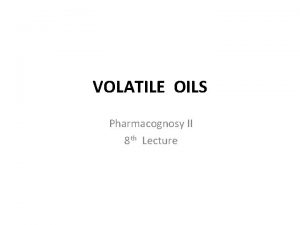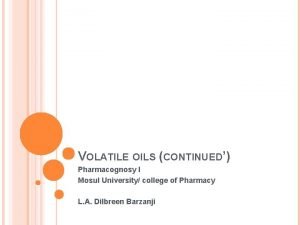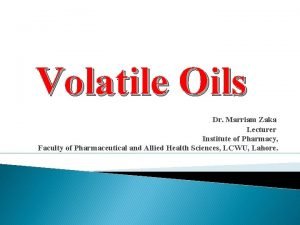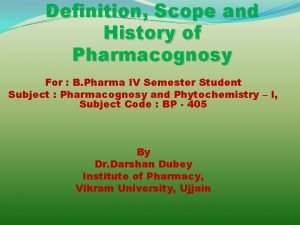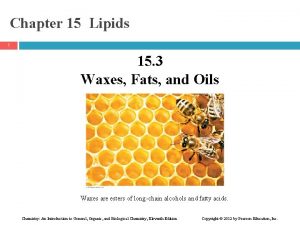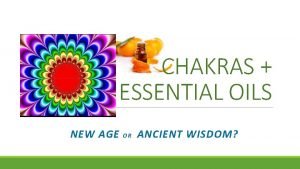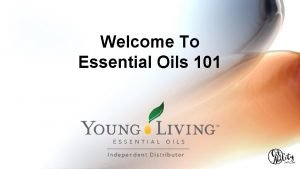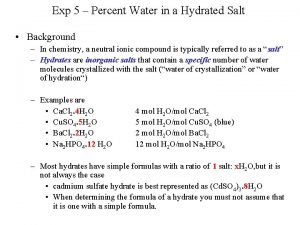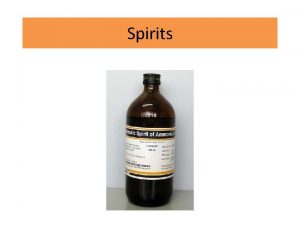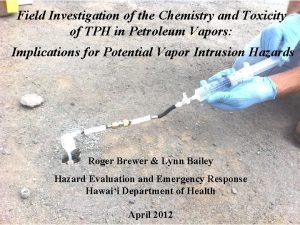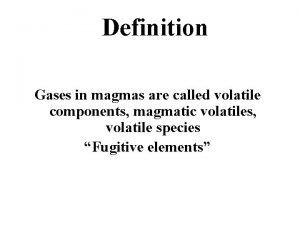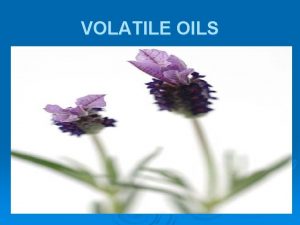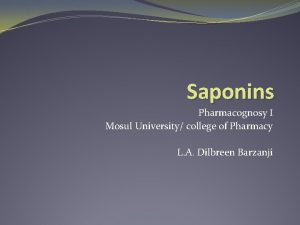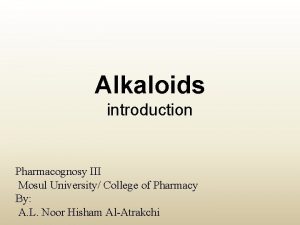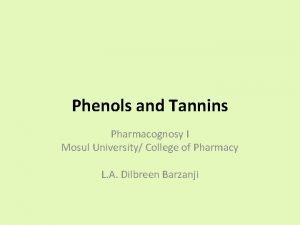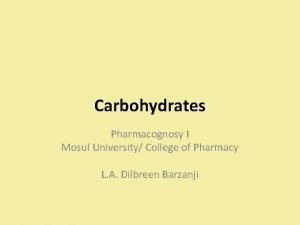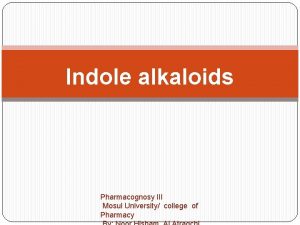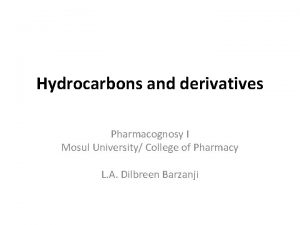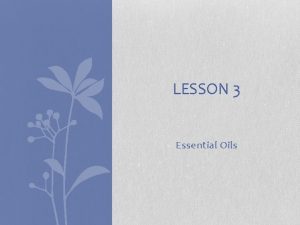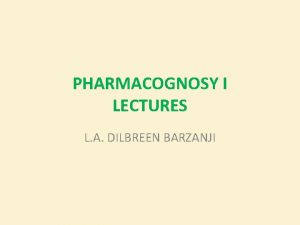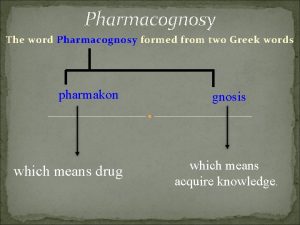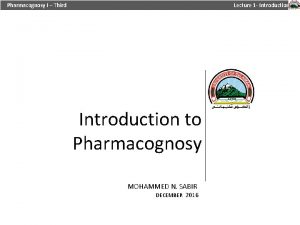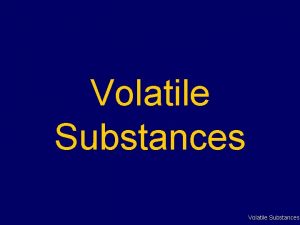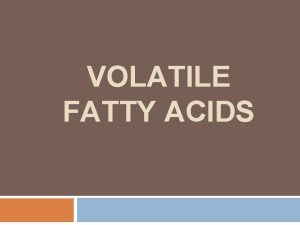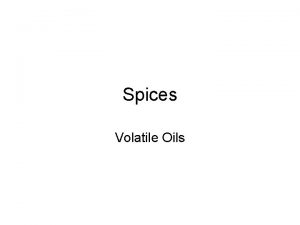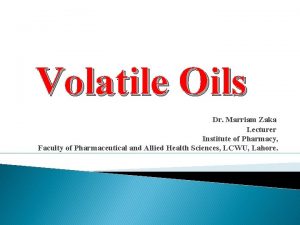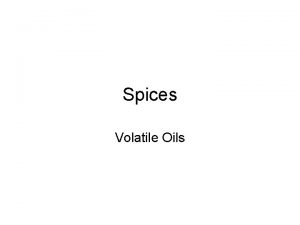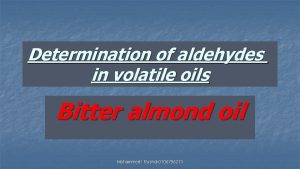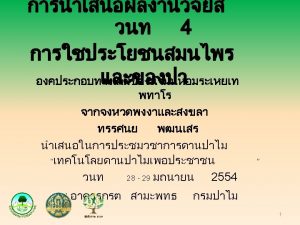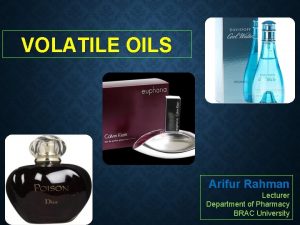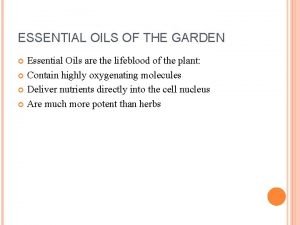Volatile oils Pharmacognosy I Mosul University college of




























- Slides: 28

Volatile oils Pharmacognosy I Mosul University/ college of Pharmacy L. A. Dilbreen Barzanji

�‘Volatile’ or ‘essential’ oils are the odorous and volatile products of various plant and animal species. �They have a tendency to undergo evaporation on being exposed to air even at an ambient temperature. �They differ entirely in both chemical and physical properties from fixed oils. �They are secreted in oil cells, in secretion ducts or cavities or in glandular hairs. They frequently associated with other substances such as gums and resins and themselves tend to resinify on exposure to air. �Large quantities of volatile oils are produced annually; as examples, for lemon oil, eucalyptus oil, clove leaf oil and peppermint oil world production annually runs into several thousand metric tons each.

Uses of volatile oils: Volatile oils are used for their therapeutic action: �for flavouring agent (e. g. oil of lemon) �in perfumery (e. g. oil of rose) �starting materials for the synthesis of other compounds (e. g. oil of turpentine)

For therapeutic purposes they are administered as: �Inhalations (e. g. eucalyptus oil) �Orally (e. g. peppermint oil) �Gargles and mouthwashes (e. g. thymol) �Transdermaly (many essential oils including those of lavender, rosemary and bergamot are employed in practice of aromatherapy). �Oils with a high phenol content, e. g. clove and thyme, have antiseptic properties �carminatives �antispasmodics

Composition of volatile oils �with the exception of oils derived from glycosides (e. g. bitter almond oil and mustard oil) volatile oils are generally mixtures of hydrocarbons and oxygenated constituents are present; in others (e. g. oil of gloves) the bulk of the oil consists of oxygenated compounds. �The odour and taste of volatile oils is mainly determined by these oxygenated constituents, which are to some extent soluble in water (note orange-flower water, rose water, etc. ) but more soluble in alcohol (note tincture or essence of lemon, etc. ). �Many oils are terpenoid in origin; a smaller number such as those of cinnamon and clove contain principally aromatic (benzene) derivatives mixed with the terpenes. A few compounds (e. g. thymol and carvacrol), although aromatic in structure, are terpenoid in origin.


Note box 1: terpenoids �Terpenoids are compounds derived from combination of two or more isoprene units, isoprene is a five carbon unit, chemically known as 2 -methyl-1, 3 butadiene. �According to isoprene rule proposed by Leopold Ruzicka, terpenoids arise from head-to-tail joining of isoprene units. Carbon 1 is called the ‘head’ and carbon 4 is the ‘tail’. �Terpenoids are classified into: monoterpenes, sesquiterpenes, diterpenes, triterpenes, tetraterpenes and polymeric terpenoids.


Note box 2: monoterpenes �Monoterpenes, 10 -carbon containing terpenoids, are composed of 2 isoprene units, and found abundantly in plants, e. g. (+)-limonene from lemon oil, and (-)linalool from rose oil. �Many monoterpenes are the constituents of plant volatile oils or essential oils. �Monoterpenes occur in plants in various structural forms; some are cyclic while others are acyclic. �They also contain various types of functional group, and depending on their functional group they can be classified as simple hydrocarbons, alcohols, ketones, aldehydes, acids or phenols.

Evaluation of volatile oil �Various pharmacopoeial procedures are given for the evaluation of volatile oils. �Odour and taste are obviously important in preliminary examination. �Physical measurements including optical rotation, relative density and refractive index are regularly employed for identification and assessment of purity; similarly. thin layer chromatograms (TLC). �Capillary gas chromatographic profiles are used to determine the proportions of individual components of certain oils. Advances in gas chromatography have now made possible detection of adulteration with synthetic material or unwanted other oils. �Other general tests described in BP include examination for fixed or resinified oils (residue after evaporation), foreign esters (conversion to a crystalline deposit) and presence of water (turbidity of a carbon disulphide solution).

Preparation of volatile oils: �Modern volatile oils stills contain a raw material on perforated trays or in perforated basket. �The still contains a water at the base which is heated by steam coils, and free steam under pressure may also be passed in. �Tough materials such as barks, seeds and roots may be comminuted to facilitate extraction but flowers are usually placed in the still without further treatment as soon as possible after collection. Distillation is frequently performed in the field.



�The distillate which consist of a mixture of oil and water, is condensed and collected in a suitable receiver which is usually a large glass jar with one outlet near the base and another near the top. �The distillate separates into 2 layers, the oil being withdrawn through the upper outlet and the water from the lower outlet, or vice versa in the case of oils, such as oil of cloves, which are heavier than water. �The oil-saturated aqueous layer may be returned to the still or may form an article for commerce, as in the case of rose water and orange-flower water.

Peppermint leaf and peppermint oil �The fresh leaves of Mentha piperita (F. Labiatae) is required to contain not less than 1. 2% of volatile oil. The oil is obtained from the same plant by steam distillation using the flowering tops. �The peppermint oil was required to contain not less than 44% of free alcohols calculated as menthol, 15 -32% of ketones calculated as menthone, and 4. 5 -10% of esters calculated as menthyl acetate. �Menthol is terpene alcohol occurs as a white crystalline solid, topical application of menthol to the skin causing refreshing cooling sensation followed by a slight burning and pickling sensation. Uses: �Peppermint oil used as inhalation (for coughs and colds), decongestant, antitussive, analgesic, anesthetic, counterirritant, anti-pruritic, enteric coated capsules containing peppermint oil used for irritable bowel syndrome.


Spearmint oil Spearmint or ordinary garden mint consists of the dried leaf and flowering top of Mentha spicata. Oil of spearmint contains (-)-carvone, (-)-limonene, phellandrene and esters. Uses: �Oil of spearmint finds wide application especially in the flavouring of chewing gums and toothpastes. The oil does not possess the medicinal virtue of peppermint oil.


Natural camphor is a white, dextrorotatory ketone, C 10 H 16 O, obtained from the wood of Cinnamomum camphora. Camphor occurs in small, colorless crystals or in transparent fibrous blocks. It has a characteristic odour and a pungent, aromatic taste, which is followed by a sensation of cold. Camphor oil contains in addition to camphor , safrole, borneol, vanillin and terpineol, a number of sesquiterpens. Uses: camphor is used externally as rubefacient, and internally as a mild antiseptic and carminative.


Eucalyptus oil Oil of eucalyptus is distilled from the fresh leaves of various species of Eucalyptus (f. Myrtaceae) and rectified. Only a ceratin number of species produce oils suitable for medicinal use. The chief requirement is a high cineole content and the absence of appreciable quantities of phellandrene and aldehydes. Suitable oils are derived from E. polybractea, E. smithii, E. globules and E. australiana. Oil of eucalyptus is a colourless or pale yellow liquid. It has an aromatic and compharaceous odour; a pungent, camphoraceous tast, which is followed by a sensation of cold. It is required to contain not less than 70. 0% of cineole. Eucalyptus oil is much used for alleviating the symptoms of nasopharyngeal infections, for treating coughs and as a decongestant. It is taken internally in the form of mixtures, inhalations, lozenges and pastilles and applied externally as ointments and liniments.


Caraway fruit and oil �Caraway consists of the dried ripe fruits of Carum carvi (f. Umbelliferae), a biennial herb about 1 m high. It occurs both wild and cultivated in central and noerthern Europe. �Caraway contains about 3 -7% of volatile oil. �Caraway oil consists largely of the ketone carvone and the terpene limonene. �Uses: the fruits and oil are used in medicine for flavouring and as carminatives. The carminative and antispasmodic properties have been experimentally verified.


Dill oil �Dill consists of the dried, ripe fruits of Anethum graveolens (f. Umbelliferae), a small annual indigenous to southern Europe. �The Dill oil resembles oil of caraway in containing carvone and limonene. The European fruits yield about 3 -4% of volatile oil, which should contain from 43 -63% of carvone. �Uses: dill is used as carminative and flavor; it is much used in infant’s gripe water.


Coriander and coriander oil �Coriander is the dried nearly ripe fruit of Coriandrum sativum, an annually about 0. 7 m high with white pinkish flower. �Coriander fruit contain up to 1. 8% of volatile oil. �The distilled oil contains 65 -70% of (+)-linalool (coriandrol), depending on the source, and smaller amounts of α-pinene, γ-terpinene, limonene and p-cymene together with various non-linalool alcohols and esters. �The unripe plant has an pleasant, mousy odour, which is also present in oil distilled from unripe fruits (mainly aldehydes such as n-decanal ). �Uses: pharmaceutically coriander and its oils are used as flavouring agent and carminative.

 Volatile oils - pharmacognosy
Volatile oils - pharmacognosy Pharmaceutical uses of volatile oils
Pharmaceutical uses of volatile oils Isovaler synonym
Isovaler synonym Pharmacognosy definition in pharmacy
Pharmacognosy definition in pharmacy 詹景裕
詹景裕 Fats, oils, and waxes
Fats, oils, and waxes Chapter 15
Chapter 15 Brian scott peskin
Brian scott peskin Importance of lipids
Importance of lipids New age oils
New age oils Essential oils
Essential oils Essential oils for pelvic congestion syndrome
Essential oils for pelvic congestion syndrome Biomolecule
Biomolecule Hydrogenation of oils
Hydrogenation of oils Owensboro grain prices
Owensboro grain prices Fats spreads and oils
Fats spreads and oils Non polar molecules that include fats oils and cholesterol
Non polar molecules that include fats oils and cholesterol Nama simplisia minyak klenteng
Nama simplisia minyak klenteng Raoult's law and dalton's law
Raoult's law and dalton's law Exp(5
Exp(5 Auxiliary emulsifying agents examples
Auxiliary emulsifying agents examples Secondary storage provides temporary or volatile storage
Secondary storage provides temporary or volatile storage Is rom volatile or nonvolatile
Is rom volatile or nonvolatile Which hydro
Which hydro Harrv
Harrv Volatile c
Volatile c Read only memory is volatile
Read only memory is volatile Volatile vs atomic java
Volatile vs atomic java Magma volatile gasses definition
Magma volatile gasses definition
